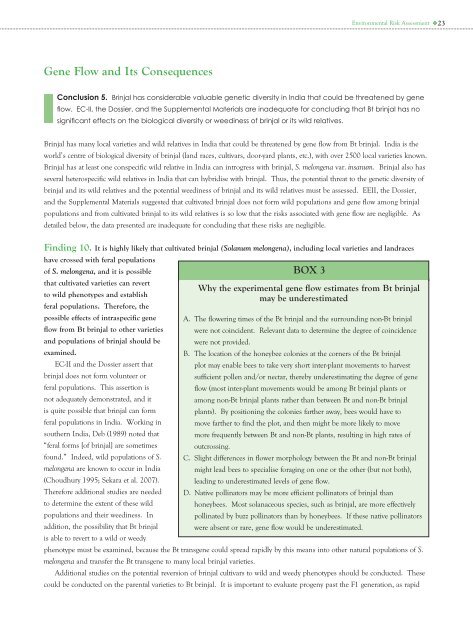Bt Brinjal The scope and adequacy of the GEAC environmental risk assessment
Bt Brinjal: The scope and adequacy of the GEAC ... - Down To Earth
Bt Brinjal: The scope and adequacy of the GEAC ... - Down To Earth
- No tags were found...
Create successful ePaper yourself
Turn your PDF publications into a flip-book with our unique Google optimized e-Paper software.
Environmental Risk Assessment 23Gene Flow <strong>and</strong> Its ConsequencesConclusion 5. <strong>Brinjal</strong> has considerable valuable genetic diversity in India that could be threatened by geneflow. EC-II, <strong>the</strong> Dossier, <strong>and</strong> <strong>the</strong> Supplemental Materials are inadequate for concluding that <strong>Bt</strong> brinjal has nosignificant effects on <strong>the</strong> biological diversity or weediness <strong>of</strong> brinjal or its wild relatives.<strong>Brinjal</strong> has many local varieties <strong>and</strong> wild relatives in India that could be threatened by gene flow from <strong>Bt</strong> brinjal. India is <strong>the</strong>world’s centre <strong>of</strong> biological diversity <strong>of</strong> brinjal (l<strong>and</strong> races, cultivars, door-yard plants, etc.), with over 2500 local varieties known.<strong>Brinjal</strong> has at least one conspecific wild relative in India can introgress with brinjal, S. melongena var. insanum. <strong>Brinjal</strong> also hasseveral heterospecific wild relatives in India that can hybridise with brinjal. Thus, <strong>the</strong> potential threat to <strong>the</strong> genetic diversity <strong>of</strong>brinjal <strong>and</strong> its wild relatives <strong>and</strong> <strong>the</strong> potential weediness <strong>of</strong> brinjal <strong>and</strong> its wild relatives must be assessed. EEII, <strong>the</strong> Dossier,<strong>and</strong> <strong>the</strong> Supplemental Materials suggested that cultivated brinjal does not form wild populations <strong>and</strong> gene flow among brinjalpopulations <strong>and</strong> from cultivated brinjal to its wild relatives is so low that <strong>the</strong> <strong>risk</strong>s associated with gene flow are negligible. Asdetailed below, <strong>the</strong> data presented are inadequate for concluding that <strong>the</strong>se <strong>risk</strong>s are negligible.Finding 10. It is highly likely that cultivated brinjal (Solanum melongena), including local varieties <strong>and</strong> l<strong>and</strong>raceshave crossed with feral populations<strong>of</strong> S. melongena, <strong>and</strong> it is possibleBOX 3that cultivated varieties can revertWhy <strong>the</strong> experimental gene flow estimates from <strong>Bt</strong> brinjalto wild phenotypes <strong>and</strong> establishmay be underestimatedferal populations. <strong>The</strong>refore, <strong>the</strong>possible effects <strong>of</strong> intraspecific gene A. <strong>The</strong> flowering times <strong>of</strong> <strong>the</strong> <strong>Bt</strong> brinjal <strong>and</strong> <strong>the</strong> surrounding non-<strong>Bt</strong> brinjalflow from <strong>Bt</strong> brinjal to o<strong>the</strong>r varieties were not coincident. Relevant data to determine <strong>the</strong> degree <strong>of</strong> coincidence<strong>and</strong> populations <strong>of</strong> brinjal should be were not provided.examined.B. <strong>The</strong> location <strong>of</strong> <strong>the</strong> honeybee colonies at <strong>the</strong> corners <strong>of</strong> <strong>the</strong> <strong>Bt</strong> brinjalEC-II <strong>and</strong> <strong>the</strong> Dossier assert thatplot may enable bees to take very short inter-plant movements to harvestbrinjal does not form volunteer orsufficient pollen <strong>and</strong>/or nectar, <strong>the</strong>reby underestimating <strong>the</strong> degree <strong>of</strong> geneferal populations. This assertion isflow (most inter-plant movements would be among <strong>Bt</strong> brinjal plants ornot adequately demonstrated, <strong>and</strong> itamong non-<strong>Bt</strong> brinjal plants ra<strong>the</strong>r than between <strong>Bt</strong> <strong>and</strong> non-<strong>Bt</strong> brinjalis quite possible that brinjal can form plants). By positioning <strong>the</strong> colonies far<strong>the</strong>r away, bees would have t<strong>of</strong>eral populations in India. Working in move far<strong>the</strong>r to find <strong>the</strong> plot, <strong>and</strong> <strong>the</strong>n might be more likely to movesou<strong>the</strong>rn India, Deb (1989) noted that more frequently between <strong>Bt</strong> <strong>and</strong> non-<strong>Bt</strong> plants, resulting in high rates <strong>of</strong>“feral forms [<strong>of</strong> brinjal] are sometimes outcrossing.found.” Indeed, wild populations <strong>of</strong> S. C. Slight differences in flower morphology between <strong>the</strong> <strong>Bt</strong> <strong>and</strong> non-<strong>Bt</strong> brinjalmelongena are known to occur in India might lead bees to specialise foraging on one or <strong>the</strong> o<strong>the</strong>r (but not both),(Choudhury 1995; Sekara et al. 2007). leading to underestimated levels <strong>of</strong> gene flow.<strong>The</strong>refore additional studies are needed D. Native pollinators may be more efficient pollinators <strong>of</strong> brinjal thanto determine <strong>the</strong> extent <strong>of</strong> <strong>the</strong>se wildhoneybees. Most solanaceous species, such as brinjal, are more effectivelypopulations <strong>and</strong> <strong>the</strong>ir weediness. Inpollinated by buzz pollinators than by honeybees. If <strong>the</strong>se native pollinatorsaddition, <strong>the</strong> possibility that <strong>Bt</strong> brinjal were absent or rare, gene flow would be underestimated.is able to revert to a wild or weedyphenotype must be examined, because <strong>the</strong> <strong>Bt</strong> transgene could spread rapidly by this means into o<strong>the</strong>r natural populations <strong>of</strong> S.melongena <strong>and</strong> transfer <strong>the</strong> <strong>Bt</strong> transgene to many local brinjal varieties.Additional studies on <strong>the</strong> potential reversion <strong>of</strong> brinjal cultivars to wild <strong>and</strong> weedy phenotypes should be conducted. <strong>The</strong>secould be conducted on <strong>the</strong> parental varieties to <strong>Bt</strong> brinjal. It is important to evaluate progeny past <strong>the</strong> F1 generation, as rapid











